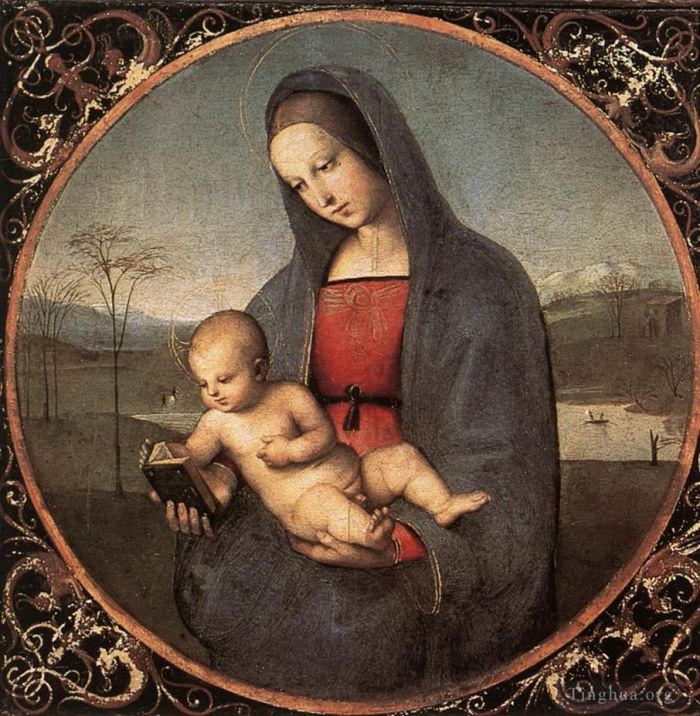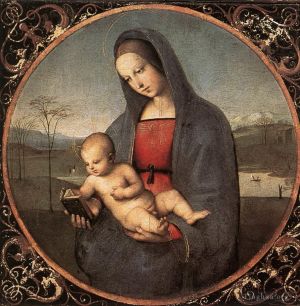Madonna and Child with the Book Connestabile Madonna
Raphael
- Price: Price on Request
- Art Type: Oil Painting
- Size:
- English Comments: 0
- International Comments: 0
- Creating Date:
- Introduction and Works of Raphael >>
Work Overview
- Madonna and Child (with the Book) (The Conestabile Madonna)
Artist Raphael
Year 1502–1504
Type Tempera on canvas transferred from wood
Dimensions 17.5 cm × 1 8 cm (6.9 in × ??)
Location Hermitage Museum, Saint Petersburg
The Conestabile Madonna is a small (and probably unfinished) painting by the Italian Renaissance artist Raphael. It was likely the last work painted by Raphael in Umbria before moving to Florence.
Its name comes from the Conestabile family of Perugia, from whom it was acquired by Alexander II of Russia in 1871. The Tsar presented it to his consort, Maria Alexandrovna. Since then, the painting has been on exhibit in the Hermitage Museum of St. Petersburg.
The painting portrays the Madonna holding the Child while reading a book. In 1881, when the picture was moved to canvas, it was discovered that in the original version the Madonna contemplated a pomegranate (symbol of the Passion) instead of the book.
Raphael entered the history of Italian art as the "genius of harmony". The ideals of the High Renaissance were best embodied in his works. The Conestabile Madonna is one of the early works by the master. Despite his still unformed style, the picture is remarkable for its superb composition, the beauty of the linear rhythms, the nobility of the colour harmonies and the perfection of the images - everything which was to be developed to such heights in Raphael's mature work. The transparency of the spring landscape in the distance is in harmony with the image of Mary - young and beautiful like the world which surrounds her. The painting is still in its original frame, decorated with grotesque ornament and evidently made to a design by Raphael himself. Before the painting was transferred from panel to canvas, the frame and the painting formed one united whole. In 1871 the Russian Tsar Alexander II purchased the painting and presented it as a gift to his wife, Maria Alexandrovna.
Before his arrival in Florence, Raphael had already had occasion to compose small-scale devotional icons of the Madonna and Child, linked to a taste for the versions created by Perugino. An interesting sequence of this type can be seen in several examples, all from around 1502 to 1504, built on the motif of the Madonna holding a book. They are known as the Solly Madonna (in Berlin), the Norton Simon Madonna (in California) and the Conestabile Madonna (in St. Petersburg).
The painting was a gift of the Conestabile family of Perugia to the Russian tzaress in 1871. When transferring to canvas at the end of the last century it was discovered that originally instead of the book there was a pomegranate in the hands of the Madonna. The landscape of the background with snow-capped peaks deserves a particular attention.
Raphael met the challenge of creating a round composition when he painted this delicate Madonna. He provides a stable structure for the round picture by means of the vertical figure of the Madonna and the horizontal lines of the landscape. The Madonna's head is gently inclined and the contour of her left hand flows rhythmically into the outline of the Christ Child's body, thus responding to the circular form.
- Copyright Statement:
All the reproduction of any forms about this work unauthorized by Singing Palette including images, texts and so on will be deemed to be violating the Copyright Laws.
To cite this webpage, please link back here.
- >> English Comments
- >> Chinese Comments
- >> French Comments
- >> German Comments
- >>Report
- Madonna della seggiola (The Madonna of the Chair)
- The Handing over the Keys
- The Annunciation Oddi altar predella
- Portrait of Baldassare Castiglione
- The Blessing Christ
- Madonna and Child with Saint John the Baptist
- Portrait of Pietro Bembo
- Portrait of Bindo Altoviti
- Pope Leo X with Cardinals Giulio deMedici and Luigi deRossi master Raphael
- Aldobrandini Madonna (The Garvagh Madonna)
- Madonna della Seggiola framed
- Angel fragment of the Baronci Altarpiece
- Portrait of a Man
- St George and the Dragon
- Lady with a Unicorn
- Madonna and Child (with the Book)
- The Granduca Madonna (The Madonna del Granduca)
- The Stanza della Segnatura Poetry
- The Stanza della Segnatura Theology
- The Transfiguration
- Holy Famliy With Saint John The baptist
- The Holy Family
- Portrait of Julius II 1511
- Portrait of a Nude Woman Fornarina 1518
- Madonna and Child with the Book Connestabile Madonna
- The Entombment Pala Baglione or The Deposition
- Self Portrait
- St George Fighting the Dragon
- Young Man with an Apple
- Madonna and Child The Small Cowper Madonna
- Portrait of Maddalena Doni
- Canigiani Holy Family (Sacra Famiglia Canigiani or Canigiani Madonna or The Holy Family with Saints Elizabeth and John)
- The Madonna of Foligno
- Portrait of a Woman La Donna Gravida
- St Sebastian 1501
- The Adoration of the Magi Oddi altar
- 4La Donna Velata
- Portrait of Cardinal Bibbiena
- Double Portrait
- The Vision of Ezekiel
- Marriage Of The Virgin
- Madonna of Belvedere Madonna del Prato
- St Cecilia with Sts Paul John Evangelists Augustine and Mary Magdalene master Raphael
- The Alba Madonna
- The Miraculous Draught of Fishes
- Portrait of a Cardinal
- Saint Michael and the Dragon
- Madonna dell Impannata
- Madonna of Loreto Madonna del Velo
- Cardinal Tommaso Inghirami
- Allegory The Knights Dream
- The Three Graces
- Joanna of Aragon
- Portrait of Agnolo Doni
- Galatea 2
- The Stanza della Segnatura The Judgment of Solomon
- The Stanza della Segnatura Philosophy
- The School of Athens
- Lamentation over the Dead Christ
- Gregory IX Approving the Decretals
- The Meeting between Leo the Great and Attila
- Studies for the Transfiguration
- Madonna and Child The Ansidei Altarpiece
- The Liberation of St Peter
- Galatea
- Waist length Figure of a Young Woman
- The Presentation in the Temple Oddi altar predella
- Study for Adam
- The Expulsion of Heliodorus from the Temple
- The Battle of Ostia
- Vision of the Cross
- The Coronation of Charlemagne
- The Stanza della Segnatura Prime Mover
- The Stanza della Segnatura Apollo and Marsyas
- Ceiling
- The Stanza della Segnatura Adam and Eve
- The Fire in the Borgo
- St Paul Preaching in Athens
- Disputation of the Sacrament
- The Parnassus
- Crucifixion Citta di Castello Altarpiece
- Head of a Woman
- Study for St Paul Preaching in Athens
- The Sistine Madonna
- The Saint Cecilia Altarpiece
- The Cardinal Virtues
- The Mass at Bolsena
- Madonna and Child Enthroned with Saints 1504
- The Death of Ananias
- Justinian Presenting the Pandects to Trebonianus
- Nude Study
- View of the Stanza di Eliodoro
- The Baptism of Constantine
- The Sibyls
- Cupid and the Three Graces
- Psyche Offering Venus the Water of Styx
- Madonna Studies
- The Stanza della Segnatura Justice
- The Battle at Pons Milvius
- View of the Stanza della Segnatura
- The Stanza della Segnatura Ceiling
- Study for the Disputa
- The Crowning of the Virgin Oddi altar
- Theological Virtues









 Singing Palette
Singing Palette